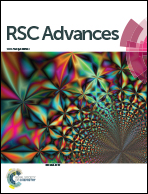Production of a natural red pigment derived from Opuntia spp. using a novel high pressure CO2 assisted-process†
Abstract
Cactus pears (Opuntia spp.) have been identified to be an excellent source of betalain pigments which can be used as a red food colourant. In this work, pigments from cactus pear fruits were effectively extracted by high pressure carbon dioxide assisted-acidified water extraction after a pre-treatment with CO2 at 375 bar, 55 °C and 60 minutes. Different process conditions, namely pressure, temperature and volume ratio of (solid–liquid mixture)/(pressurized CO2), were tested in order to model the extraction of betalains from prickly pears via the response surface methodology. The best response was achieved at 100 bar, 40 °C and 20% volume ratio of (solid–liquid mixture)/(pressurized CO2). Under these conditions, the betalains yield was 89 ± 0.7 mg per 100 g of dried fruit, 83% of the maximum extractable pigments from Opuntia spp. fruits. Furthermore, Opuntia spp. extracts presented a vivid red colour with high antioxidant activity.


 Please wait while we load your content...
Please wait while we load your content...